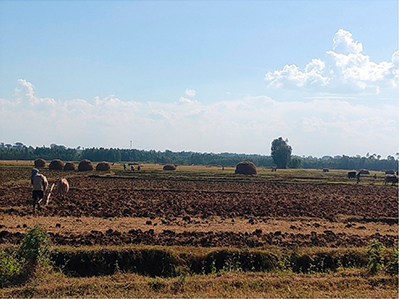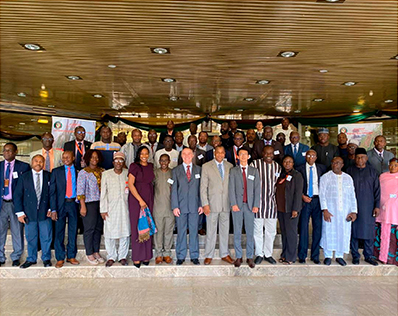Stories from the Field 04
A Platform for Increasing Rice Production in Africa
—CARD Activities that Connect African Countries with International Organizations—

Rice fields in Fogera Plain in Amhara Region, Ethiopia. Farmers start cattle plowing for the next crop immediately after harvesting. (Photo: CARD Secretariat)

A consultative meeting for the formulation of the “Rice Offensive,” a regional rice strategy for the Economic Community of West African States (ECOWAS), in Abuja, Nigeria. Director-general level officials from the agricultural ministries of 14 countries participated alongside representatives from various international organizations to finalize the formulation process of the ECOWAS version of rice development strategy. (Seventh from the right: Dr. Haneishi) (Photo: CARD Secretariat)
Since the 1990s, in Africa, where the economic growth has been remarkable, there has been a greater demand for rice production as rice consumption has increased along with Africa’s rapid population growth and urbanization. In addition, agriculture is an important industry for Africa, accounting for more than 20% of GDP in as many as 30 African countries. Therefore, it is essential to support farmers and raise the level of food self-sufficiency for continued sustainable growth. In particular, under the current situation where food prices are rising due to global circumstances, leading to the food crisis in the continent, it is becoming increasingly important to improve food self-sufficiency in African countries.
At the Fourth Tokyo International Conference on African Development (TICAD IV) in 2008, JICA, in partnership with an international NGO, Alliance for a Green Revolution in Africa (AGRA), launched an initiative called the “Coalition for African Rice Development (CARD),” aiming at doubling Africa’s rice production. Currently, CARD involves 32 African member countries, with 14 international organizations and 5 African Regional Economic Communities (RECs) as supporting partners.
Dr. HANEISHI Yusuke, General Coordinator of the CARD Secretariat, explains CARD as follows: “Development partners, including JICA, support the formulation of the National Rice Development Strategy (NRDS) in each member country and provide assistance for increasing their rice production in line with the strategies. The CARD Secretariat monitors the implementation of the NRDS in each country.”
The CARD initiative achieved the goal of doubling rice production in Africa (from 14 million tons to 28 million tons) and completed its first phase in 2018. In the second phase, which commenced in 2019, CARD aims at further increasing production toward 2030 as well as promoting a strategy based on four perspectives called “RICE,” which stands for “Resilience,” “Industrialization,” “Competitiveness,” and “Empowerment.” In order to improve rice “productivity” and “quality,” which were revealed as challenges in the first phase, CARD has begun efforts to increase the yield per unit area Note 1 by focusing on new research and development of seeds and farming methods, as well as strengthening the capacity of rice millers to raise the competitiveness of domestic rice.
“The CARD initiative, led by Japan for more than 10 years, is now recognized by international organizations and donor countries as an established platform for rice. Even without support from the CARD Secretariat and JICA, African countries themselves reach out to CARD member donors for assistance in implementing their NRDS. In addition, the number of offers of assistance from non-member donors has also increased, and each member country obtains assistance based on their NRDS and puts it into practice for promoting the rice sector development. This is a great achievement for CARD, as it has supported the ownership of African countries,” says Dr. Haneishi.
In this way, CARD has not only achieved increased rice production successfully in African countries, but also demonstrated a strong presence as a platform that connects member countries with development partners. Through the CARD initiative, JICA will continue to provide assistance for food security in Africa with various partners.
Note 1: Numerical value that indicates how much of a crop is harvested per unit area. It is calculated by dividing the total amount of crops harvested by the unit area.
<< Previous Page Next Page >>
Main Text | Reference Statistics | Appendix | Stories from the Field | Master Techniques from Japan to the World | ODA Topics
